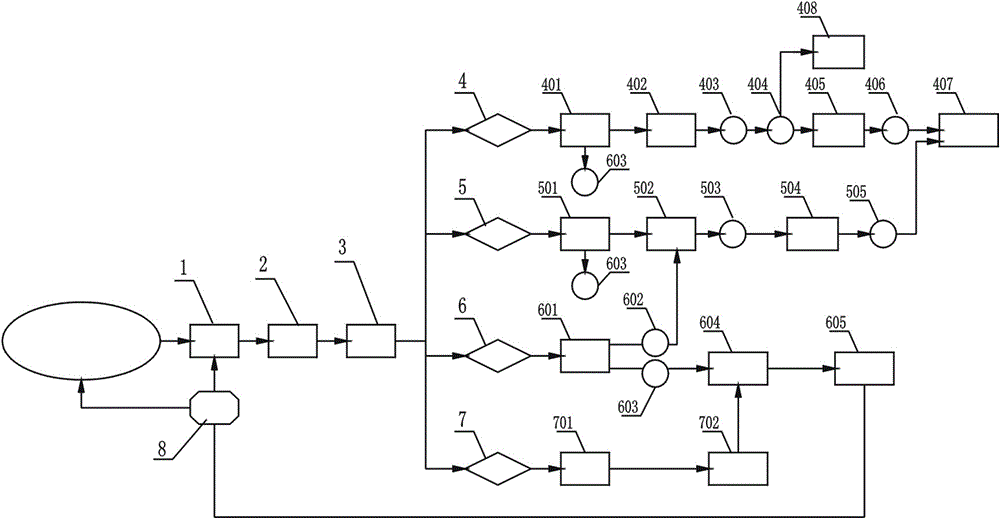Comprehensive zoning treatment method for soil heavy metal pollution
A technology of heavy metals and polluted areas, applied in the restoration of polluted soil, etc., can solve the problems of long duration, endangering human health, soil degradation, etc., and achieve the effect of reducing disposal costs, avoiding secondary pollution, and good remediation effect
- Summary
- Abstract
- Description
- Claims
- Application Information
AI Technical Summary
Problems solved by technology
Method used
Image
Examples
Embodiment 1
[0024] Embodiment one: if figure 1 As shown in Fig. 1, a method for comprehensive remediation of soil heavy metal pollution by area, including the following steps: area monitoring (1), pollution degree identification (2), site leveling in polluted areas (3), soil heavy metal pollution disposal and assessment monitoring (8);
[0025] Among them, the sub-regional monitoring (1) step: determine the monitoring items and divide the areas according to the soil environmental quality standards. Zn, Ni, for partition monitoring;
[0026] Pollution degree identification (2) step: Through sampling and analysis of the polluted area and the surrounding polluted area, determine the pollution degree of each area, and according to the monitoring results, the treatment is divided into: treatment of extremely heavily polluted areas (4), treatment of heavily polluted areas (5) Treatment of general polluted areas (6) and lightly polluted areas (7), in which the monitoring results are compared wi...
Embodiment 2
[0035] Embodiment 2: Take the waste residue with a weight of 100Kg and solidify it. First, crush and sieve the waste slag to make the particle size of the waste slag meet the molding requirements, then mix 1Kg of stabilizer and 100Kg of waste slag, after stirring evenly, carry out dry mixing with 40Kg of cement, and then gradually add 10Kg of water for overall mixing. The total time of mixing and stirring is about 5 minutes. Considering the feeding and discharging time, a mixing cycle is about 10 minutes; mold loading and vibration: put the mold on the ground of the forming area, apply the release agent, place it stably, and put it into the mold first Add 1 / 2 of the mixture, vibrate and compact, then fill up the mixture, continue to vibrate until there are no obvious air bubbles, and do not over-vibrate during vibration to cause "moulding"; demoulding: mold according to the mixture and smooth the bottom surface After the final setting of the concrete, it shall be covered in ti...
Embodiment 3
[0036] Example 3: Pollution degree identification (2) The evaluation is generally based on a single pollution index, with a small index causing light pollution and a large index causing heavy pollution. When the soil environmental quality in the area is compared with the outside area as a whole or with historical data In addition to the individual pollution index, the comprehensive pollution index is also commonly used. Due to the large differences in the regional background of the soil, the soil pollution accumulation index can better reflect the degree of man-made pollution of the soil. The soil pollutant share rate can be evaluated to determine the main pollution items of the soil. The pollutant share rate is sorted from large to small, and the priority of pollutants is also the same. In addition, statistics such as the multiple of soil pollution exceeding the standard and the rate of sample exceeding the standard can also reflect the environmental status of the soil. The c...
PUM
 Login to View More
Login to View More Abstract
Description
Claims
Application Information
 Login to View More
Login to View More - R&D
- Intellectual Property
- Life Sciences
- Materials
- Tech Scout
- Unparalleled Data Quality
- Higher Quality Content
- 60% Fewer Hallucinations
Browse by: Latest US Patents, China's latest patents, Technical Efficacy Thesaurus, Application Domain, Technology Topic, Popular Technical Reports.
© 2025 PatSnap. All rights reserved.Legal|Privacy policy|Modern Slavery Act Transparency Statement|Sitemap|About US| Contact US: help@patsnap.com

